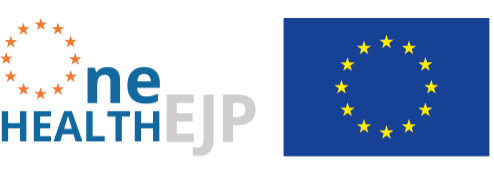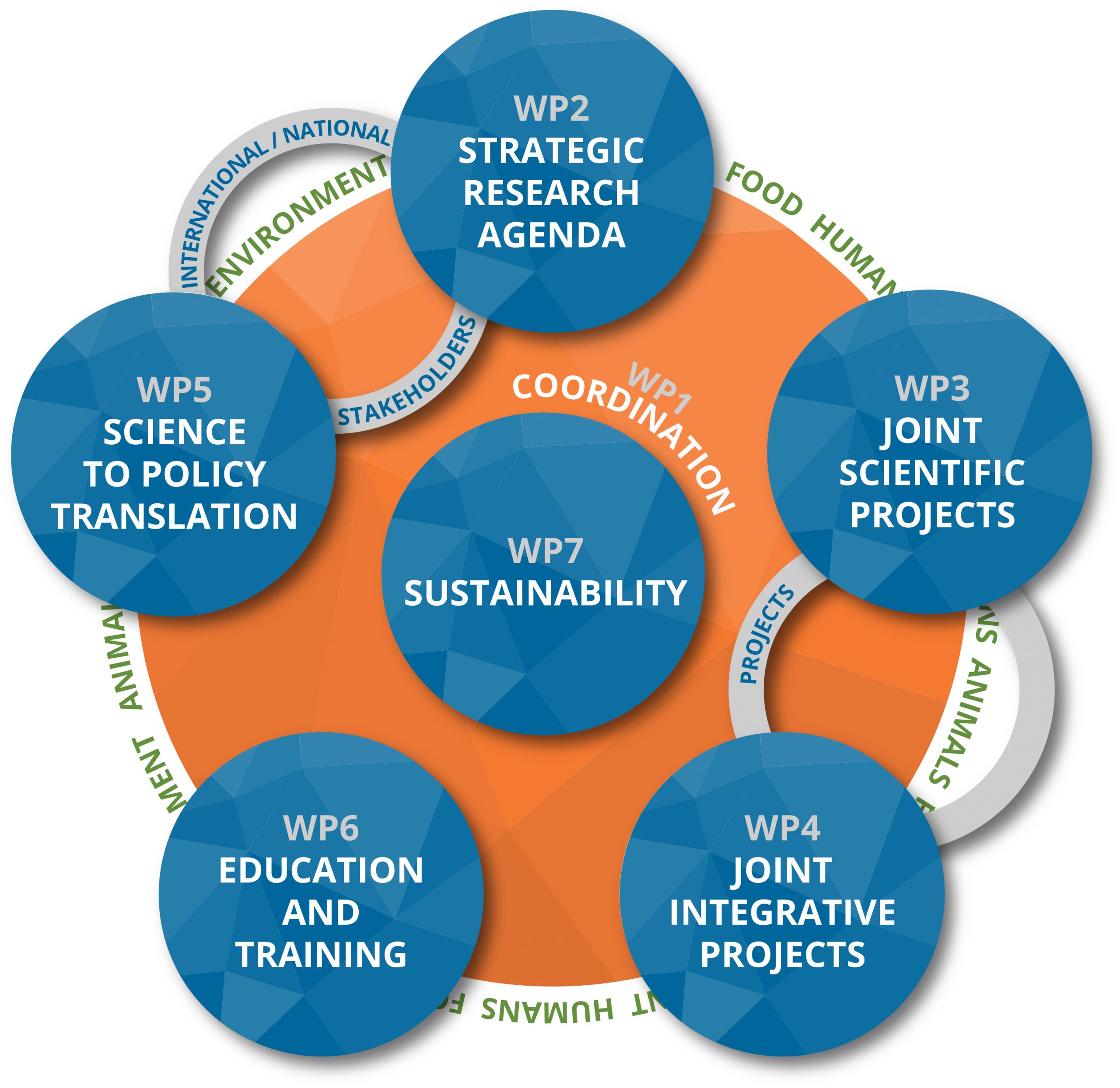Work Packages
The One Health EJP (OHEJP) work plan is structured in seven work packages, each targeted towards specific overarching needs and objectives, as well as ensuring alignment and integration in the implementation of the programme. A visual representation of the structure of the One Health EJP and the respective work packages (WP) are described in the figure to the right.
Work Package 1: Coordination
The objective of the work package WP1 is to enable the successful functioning of the OHEJP, with an environment within which the scientists can effectively and actively collaborate. It establishes sustainable management-based mechanisms, procedures and processes to enable the integration, alignment and sustainability in the OHEJP consortium. The network is managed by the constitution of three bodies, a Programme Managers Committee (PMC), a Scientific Steering Board (SSB) and the Project Management Team (PMT), supported by a Support Team (ST) for the daily follow-up of the science, administrative duties, financial and legal matters.
WP1 is also responsible for leading the OHEJP communication activities, including the development of a communication strategy. The OHEJP communication strategy ensures that the programme is well publicised and scientific results highly promoted. The communication team maintains the website interface, creates internal and external newsletters, writes external press releases and other articles, disseminates OHEJP news on the social media networks of LinkedIn and Twitter .
Work Package 2: Integrative Strategic Research Agenda
The objective of WP2 is to identify research and integrative priority topics in the domains of foodborne zoonoses (FBZ), antimicrobial resistance (AMR) and emerging threats (ET) to align research agendas and priorities in capacity building that can be met through integration by developing and maintaining an integrative Strategic Research Agenda (SRA). This SRA forms the basis for the Joint Research Projects and Joint Integrative Projects (WPs 3 and 4).
Furthermore, WP2 is also responsible for prospectively exploring opportunities for strategic interactions with related European research projects and initiatives. WP2 works on developing strategic collaborations with our stakeholders EFSA, ECDC, JPI AMR, EU-JAMRAI, COMPARE and EFFORT. This facilitates the harmonisation of approaches, methodologies, databases and procedures in the assessment and management of foodborne hazards, emerging threats and AMR across Europe, which improves the quality and compatibility of information for decision making.
Work Package 3: Joint Research Projects (JRP)
Joint research projects (JRP) are scientific projects that correspond to the priorities described in the strategic research agenda as defined by WP2 and consider the initiatives taken by the main stakeholders EFSA and ECDC (WP5). They are implemented in the three domains of the OHEJP (FBZ, AMR and ET) and cover the five themes (detection, pathogenesis, epidemiology, risk assessment and intervention).
JRP is an instrument that carries out jointly prioritised research and works with partners to align their laboratory tests, organise ring trials, exchange strain collections, surveillance and typing data and experience and research effort to broaden and strengthen their capacity and international networking. WP3 is responsible for organising selection, supervision and evaluation of the JRPs that are implemented in response to the needs identified in the SRA, as defined by WP2 and in collaboration with WP4. WP3 also promotes the output from JRPs by organisation of annual scientific meetings in collaboration with WP1, WP4 and WP6.
Work Package 4: Joint Integrative Projects (JIP)
Joint Integrative Projects (JIPs) develop joint resources (infrastructure and work processes) across the three domains of the OHEJP (FBZ, AMR and ET), through capacity building within the disciplines defined by the five themes (Detection, Pathogenesis, Epidemiology, Risk Assessment, Intervention).
JIPs contribute to the integration and alignment of institutional activities in line with European policy priorities, and thereby strengthen both the scientific capacity within the OHEJP and also future prevention, preparedness, detection and response of the EU to foodborne and other emerging threats across human-animal-environmental sectors.
WP4 is responsible for organising selection, supervision and evaluation of the JIPs that are implemented in response to the needs identified in the SRA as defined by WP2. WP4 implements additional integrative instruments , including workshops (with WP2), short-term integrative missions and mentoring activities (with WP6), and internal and international meetings (with WP1, WP3 and WP6). WP4 is responsible for development of the Data Management Plan for the OHEJP and for supporting its implementation.
Work Package 5: Science to Policy Translation
“Science to policy translation” aims to ensure best use of the outcomes of the JRPs and JIPs (see WP3 and 4) by establishing appropriate dissemination activities and by taking part in relevant networking activities such as consultations with stakeholders. These collaboration procedures with stakeholders are established with procedures implemented to identify stakeholder’s needs in the field of FBZ, AMR and ET. WP5 maintains an open and transparent dialogue with EFSA and ECDC and other relevant international policy-makers that includes: World Health Organisation for Animal Health (OIE), World Health Organisation (WHO), and Food and Agriculture Organisation (FAO). This ensures that policy needs are absorbed by the OHEJP governing structure and WP2, such that output from activities in WPs 3 and 4 are taken up by policy initiatives and used to address the protection of consumers’ health. WP5 functions as a channel to disseminate new science, tools and materials from the OHEJP to stakeholders, including EU policy makers (European Commission, EC) and EU agencies (EFSA and ECDC). The capacity and expertise of the consortium for research and preparedness in the field is made transparent and developed by integration activities within the consortium, and interaction or alignment with other consortia.
Work Package 6: Education and Training
The objective of WP6 is to develop and deliver innovative training platforms with a specific focus on One Health. WP6 provides a sustainable framework for educational integration of research groups and reference laboratories across the partner network. WP6 networks also take advantage of synergies with the EU programme Better Training for Safer Food (BTSF).
The OHEJP has a multidisciplinary integrative doctoral training programme, focused on the main themes of the OHEJP (FBZ, AMR and ET). WP6 provides training for students, early career researchers, and professionals through a series of summer schools, short-term missions and continuing professional development events. WP6 is responsible for organising the submission, selection and evaluation of PhD proposals, summer schools, training workshops, continuing professional development events, and administering short term missions for OHEJP partners.
Work Package 7: Sustainability
WP7 works to ensure that the experience and lessons learnt from the One Health OHEJP result in a solid collaboration among the Programme Owners from participating Member States. This ensures there is willingness to profit from these experiences for long-term sustainability. The societal challenges that are covered by the OHEJP extend though the length of the programme, including the need of new knowledge to support policies in the field. Consequently, the OHEJP consortium must examine ways to maintain its developed cooperative structures. In response, WP7 explores operational means to sustain long-term research and innovation beyond the duration of the OHEJP. WP7 works on carrying out a systems analysis of the drivers and constraints with regard to the successful institutionalisation of One Health, which is a key precursor to sustainability.



